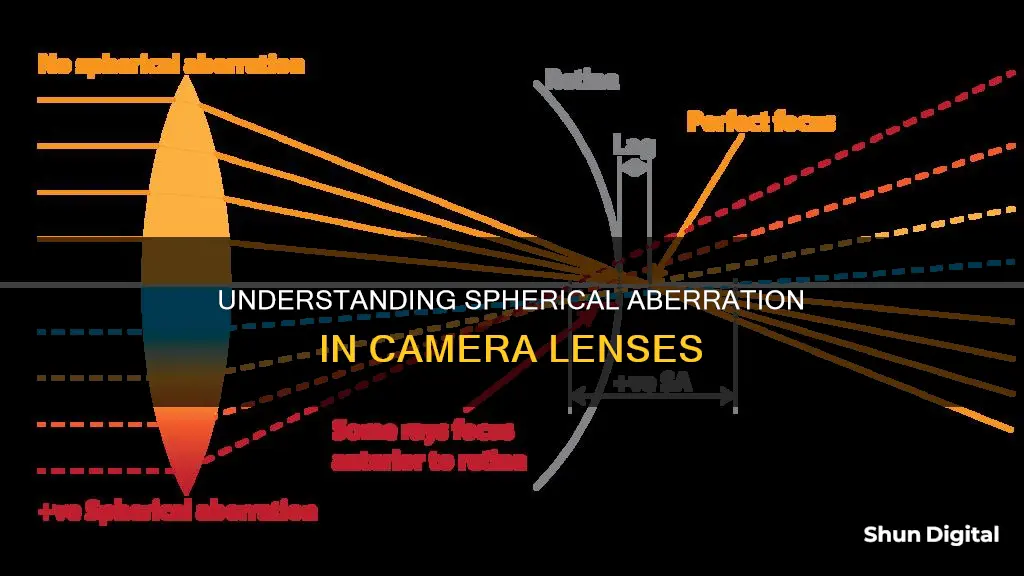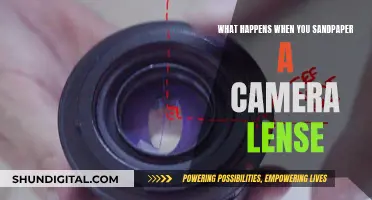
Spherical aberration is a common issue in photography, causing a decrease in image quality. It occurs when light rays entering a lens do not converge at a single point, resulting in blurriness and loss of sharpness. This phenomenon is influenced by the shape of the lens and the quality of the lens material. Spherical lenses, due to their curved structure, refract light rays differently, with rays closer to the edge of the lens bending more than those near the centre. This deviation leads to a reduction in image resolution and clarity, making it challenging to obtain sharp images. To address this issue, modern lenses employ techniques such as using aspherical lens surfaces or stopping down the lens aperture to minimise the impact of spherical aberration.
| Characteristics | Values |
|---|---|
| Definition | Spherical aberration is a type of aberration found in optical systems that have elements with spherical surfaces. |
| Cause | Spherical aberration is caused by the shape of the lens. |
| Effect | Spherical aberration causes a decrease in image quality, clarity, sharpness and resolution. |
| Corrective measures | Spherical aberration can be corrected by using aspherical lenses, aplanatic lenses, or a combination of convex and concave lenses. |
| Aperture | Using a smaller aperture can reduce the effects of spherical aberration by blocking out-of-focus light from the edges of the lens. |
What You'll Learn

Spherical lenses and their impact on light refraction
Spherical aberration is a common issue in optics, affecting lenses and curved mirrors due to their spherical shape. This phenomenon causes a reduction in image quality as light rays are refracted or reflected to varying degrees depending on where they strike the lens surface. Spherical aberration is particularly problematic for telescopes and cameras, resulting in blurry images with poor resolution and clarity.
When light rays pass through a spherical lens, those closer to the edge are refracted more than those near the centre, causing them to converge at different points. This is because light rays passing through a lens near its horizontal axis are refracted less than those closer to the periphery. As a result, the parallel light rays do not converge at a single point, affecting the image's sharpness and clarity. The effect is more pronounced at short focal ratios, or "fast" lenses, and can be minimised by using combinations of convex and concave lenses or aspheric lenses.
The impact of spherical aberration was first identified in the 11th century by Ibn al-Haytham, who discussed it in his work "Kitab al-Manazir". Modern lenses employ various techniques to reduce this issue, such as using aspherical lens surfaces or stopping down the lens to block the outer edges. Additionally, lens systems with aberration correction can be designed using numerical ray tracing or analytical calculations to minimise spherical aberration.
Spherical aberration can also be minimised by using a small aperture, as this blocks the out-of-focus light coming from the edges of the lens, resulting in a sharper image. However, this method reduces the brightness of the image. Another way to correct for spherical aberration is by adjusting the physical shape of the lens elements, such as grinding the lens to protrude more near the centre and making adjustments to the edges.
In summary, spherical lenses impact light refraction by causing spherical aberration, where light rays are refracted to varying degrees depending on their distance from the centre of the lens. This results in a decrease in image quality, particularly in terms of sharpness and clarity. While there are techniques to minimise this issue, it is a common challenge in optics and photography.
Lens Thread Compatibility: A Universal Camera Feature?
You may want to see also

The effect of lens aperture on spherical aberration
Spherical aberration is a common issue in optical systems with elements that have spherical surfaces, such as lenses and curved mirrors. This phenomenon occurs because light rays that strike a spherical surface off-centre are refracted or reflected differently from those that strike close to the centre, resulting in a reduction in image quality.
By reducing the aperture size, or stopping down the lens, spherical aberration can be minimised. Even a small reduction in aperture size can have a significant impact. This is because the aperture blades block the outer edges of the lens, reducing the amount of light that can cause the aberration. As a result, a smaller aperture will generally give a sharper image with greater depth of field.
The amount of spherical aberration also depends on the shape of the lens. Bending or adjusting the lens into its best form can minimise the aberration. Additionally, the use of symmetric doublets, such as orthoscopic doublets, can greatly reduce spherical aberration. In some cases, it may be necessary to use multiple spherical elements or specialised aspherical lenses to compensate for the aberration.
Modern lenses employ various techniques to reduce spherical aberration, including the use of aspherical lens surfaces, which are curved outwards on one side to converge light rays into a single focal point.
Kowa C-Mount Lenses: Compatibility with Various Camera Models
You may want to see also

Lens design and the quality of lens material
Spherical aberration is an optical issue that occurs when incoming light rays focus at different points after passing through a spherical surface. This happens because light rays that pass through a lens near its horizontal axis are refracted less than those closer to the edge of the lens, resulting in different focal points along the optical axis.
One technique to reduce spherical aberration is to use a non-spherical or "apsherical" lens surface, which is curved outwards on one side to converge light rays into a single focal point. This type of lens surface was first described by Descartes, who showed that lenses with well-chosen Cartesian oval shapes could produce aberration-free focusing of light from distant sources. In 2018, researchers from Mexico further contributed to this area by discovering a closed formula for a lens surface that eliminates spherical aberration.
In addition to lens design, the quality of the lens material also plays a role in spherical aberration. Lenses made of poor quality materials or containing large bubbles can significantly impact light refraction, leading to suboptimal image quality.
It is worth noting that spherical aberration is not considered a manufacturing flaw but rather an inherent aspect of lens design. It is a complex optical phenomenon that has been recognised since the 11th century, and modern lens designs continue to optimise techniques to minimise its effects.
Camera Lenses: Yardage Vision Range Explored
You may want to see also

The impact of spherical aberration on image quality
Spherical aberration is a common issue in optics that can significantly impact image quality. It occurs when light rays passing through a lens fail to converge on a single point, resulting in a blurred image. This phenomenon is especially prominent in spherical lenses due to their shape and ease of manufacturing. The impact of spherical aberration on image quality is twofold: it affects both the resolution and clarity of images.
Firstly, spherical aberration can cause blurriness at the edges of an image, similar to the effect seen in magnifying glasses. This blurriness is a result of light rays being refracted to different degrees depending on where they strike the lens surface. Rays passing through the centre of the lens are refracted less than those closer to the edge, resulting in multiple focal points. Consequently, the centre of the image may appear sharp while the periphery is out of focus. This loss of sharpness can extend to a significant portion of the image, potentially obscuring vital details.
Secondly, spherical aberration can also affect the overall clarity and resolution of an image. Since the light rays do not converge on a single point, the image produced may appear hazy or lack sharpness. This decrease in image clarity can be particularly noticeable in high-contrast situations, where it may manifest as a coloured haze or "fringe" around the subject. The presence of these aberrations can make it challenging to obtain crisp and detailed photographs, especially when capturing intricate or small subjects.
The impact of spherical aberration is more prominent when using wider apertures, as the phenomenon is inversely proportional to the cube of the focal length. This means that shorter focal lengths, often referred to as "fast" lenses, are more susceptible to spherical aberration. Additionally, the effect is more pronounced in lenses with larger diameters, as it is proportional to the fourth power of the diameter.
To mitigate the impact of spherical aberration on image quality, photographers and lens manufacturers have developed several techniques. One common approach is to utilise aspheric lenses, which have a non-spherical surface that helps direct light rays to a single focal point. Another method is to employ combinations of convex and concave lenses within the optical system to minimise aberrations. Additionally, stopping down the lens (reducing the aperture size) can help block the outer edges of the lens, improving image sharpness.
Best Budget Camera Lenses: Enhance Photography Under $200
You may want to see also

Correcting spherical aberration with aspherical lenses
Spherical aberration is a common problem in optical systems that use lenses or curved mirrors with spherical surfaces. This phenomenon occurs because light rays that strike a spherical surface off-centre are refracted or reflected more or less than those that hit closer to the centre. As a result, the light rays do not converge at a single point, leading to reduced image quality.
To correct spherical aberration, aspherical lenses can be used. An aspherical lens has a non-spherical surface, which is curved outwards on one side. This design allows the lens to converge light rays into a single focal point, eliminating the issue of blurriness at the edge of an image caused by spherical aberration.
The use of aspherical lenses can be more expensive than traditional spherical lenses, as they are more challenging to manufacture. However, they offer improved image quality by reducing the deviation of light rays. This is especially important in applications such as precision agriculture, aerial imaging, and microscopy, where edge-to-edge sharpness and image analysis are critical.
In addition to aspherical lenses, there are other methods to minimise spherical aberration. One approach is to use a combination of convex and concave lenses, which can help compensate for the aberration. Another method is to adjust the radii of curvature of the front and back surfaces of the lens to minimise the effect. Additionally, stopping down the lens by reducing the aperture size can help mitigate spherical aberration, although it also reduces the brightness of the image.
In recent years, advancements in optical systems have led to ongoing improvements in lens designs. Researchers have also discovered equations that can specify lens surfaces to eliminate spherical aberration, further enhancing our ability to correct this optical imperfection.
Lens Compatibility: Understanding Camera Lens Interchangeability
You may want to see also
Frequently asked questions
Spherical aberration is a phenomenon in optics where light rays passing through a lens do not converge at a single point, resulting in a blurry image. This occurs due to the spherical shape of the lens, which causes light rays to refract or reflect at different angles depending on where they strike the lens surface.
Spherical aberration happens because light rays passing through a spherical lens are refracted differently. Rays passing through the lens near its centre are refracted less than those closer to the edge, resulting in different focal points. This deviation from the ideal focus reduces the sharpness and clarity of the image.
Spherical aberration can be minimised by using specialised techniques and lens designs. One method is to use aspherical lenses, which have a non-spherical surface to bring light rays into a single focal point. Additionally, stopping down the lens (reducing the aperture) can help mitigate spherical aberration by blocking the outer edges of the lens.







